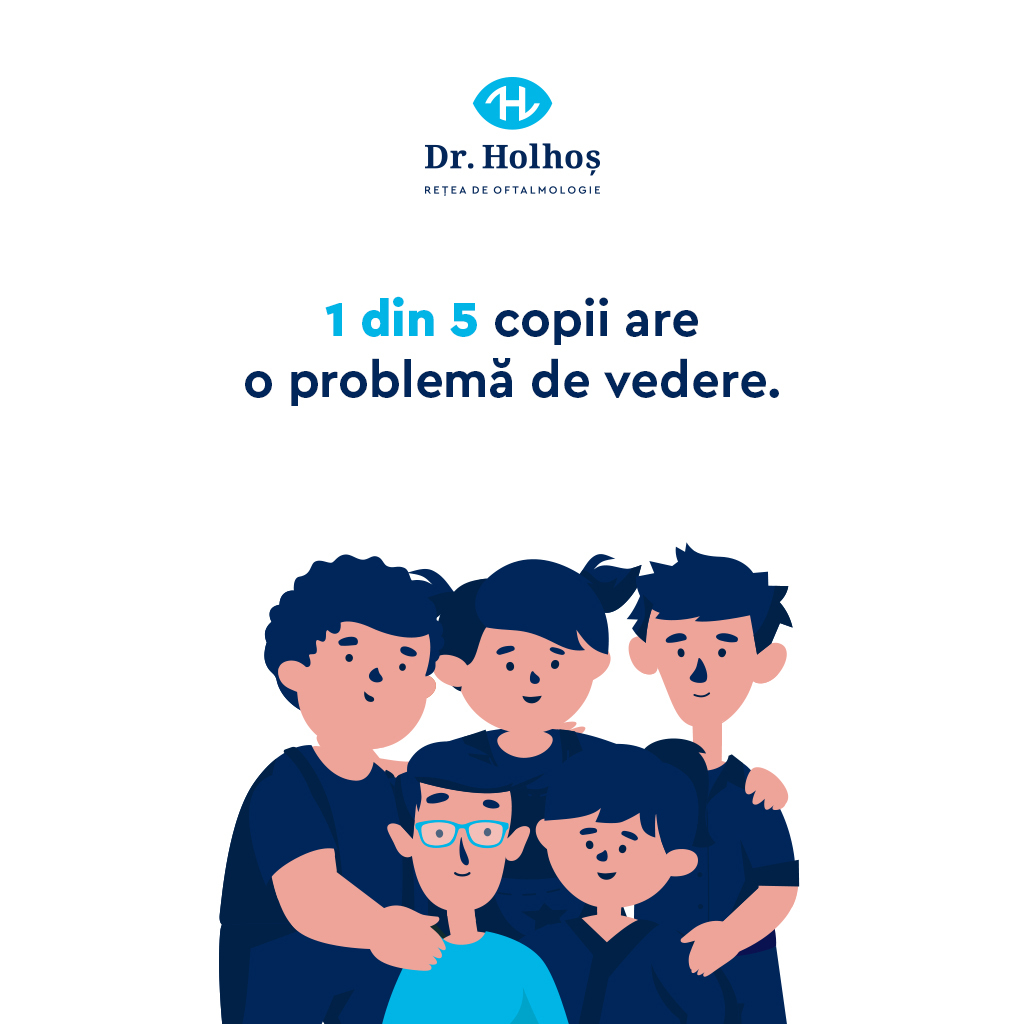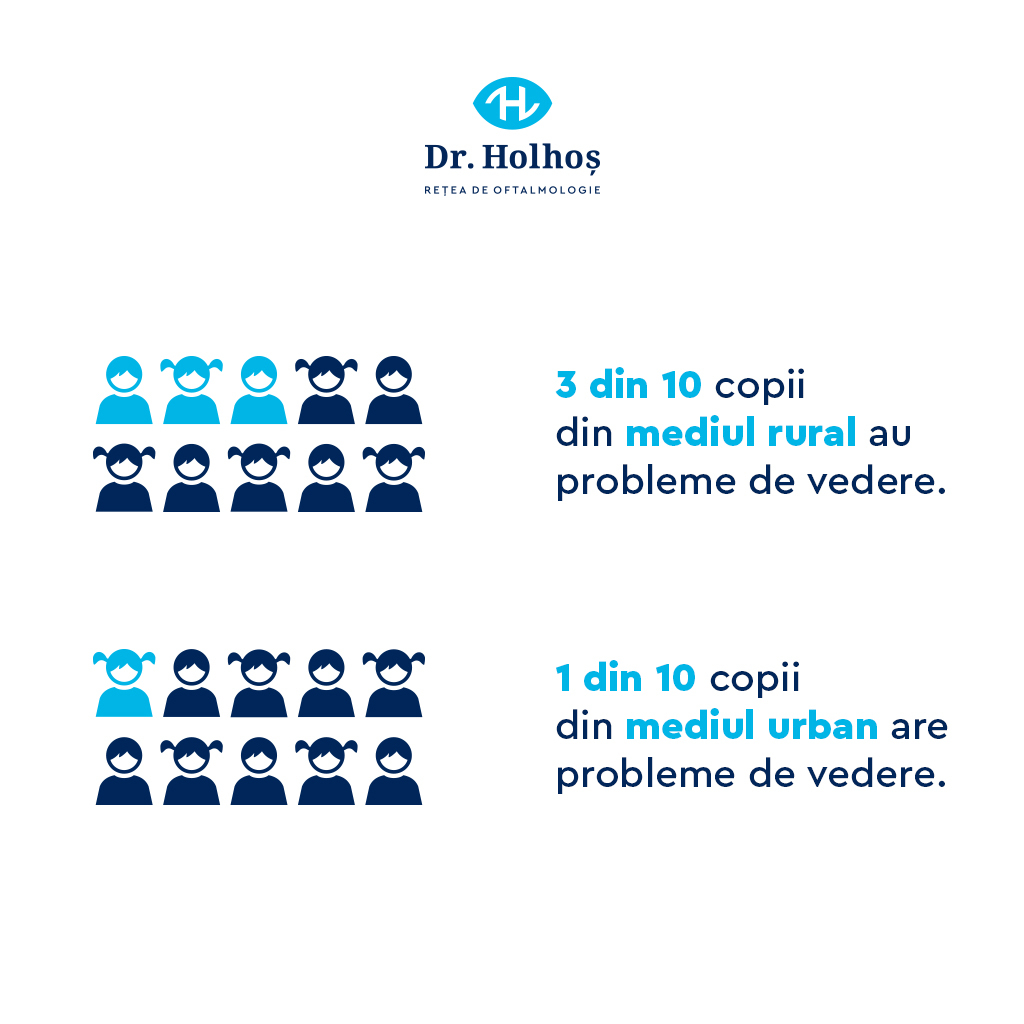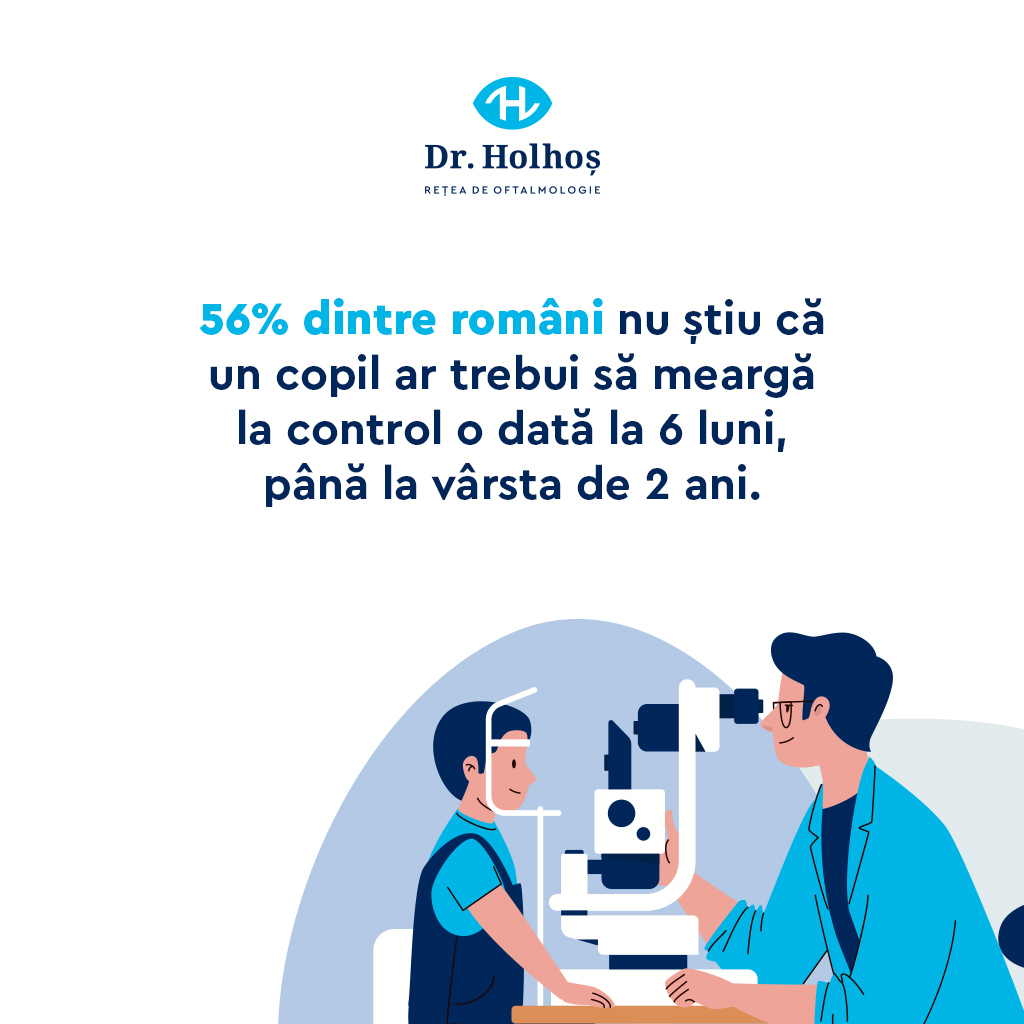- Hypermetropia is the most common vision problem in preschoolers
- 3 out of 10 children in rural areas have a visual disorder
- 56% of Romanians do not know that a child should go for a check-up every 6 months until the age of 2
From September 2022 to January 2023, the Dr. Holhoș ophthalmology network carried out a free screening campaign for preschoolers, which aimed to detect early any refractive errors in young children and to raise awareness of the importance of eye check-ups in children. The young patients were screened using the state-of-the-art Plusoptix, a specially developed technology for non-invasive eye screening. The testing was carried out from 1 meter away and it was all in the form of play, so the little ones felt safe throughout the whole process.
The results of the campaign showed what the most common visual problems are, how much more rural children are affected than urban children, and how important prevention and early correction of ophthalmological disorders are.
All this is highly relevant in a context where the time spent in front of screens is increasing and the pandemic and vitamin D deprivation have aggravated vision problems. A study by the Association of Ophthalmologists shows that online schooling has increased the amount of time children spend in front of screens by up to 20 times, estimating that around 5 billion people will have vision problems in the next 30 years.
Hypermetropia is the most common vision problem in preschoolers
The main finding was that out of 1150 tested preschool children, 20% were found to have a vision problem. This makes sense given that most ophthalmological disorders are genetic.

The most common condition found in preschool children included in this screening campaign was hypermetropia. Patients with hypermetropia have difficulty seeing well the near objects. In preschool children, this condition is usually genetic and it is important that the problem is addressed early. Untreated hypermetropia can lead to amblyopia, also known as “lazy eye”. This is because the poorly sighted eye is “ignored” by the brain, and if the refractive error remains uncorrected, there is a risk that the affected eye may never see as well as the healthy one. It’s important to note that most children are born with a mild form of hypermetropia, which doesn’t require glasses and shouldn’t worry us. Preschoolers’ visual activities include up-close effort, but are also combined with lots of outdoor, outside play, which allows for more eye relaxation.
The second most common ophthalmological problem in preschool children was astigmatism. Preschoolers with astigmatism see in a blur regardless of the distance objects are located. The condition can be both genetic, but can also occur at young ages.
Myopia was the third most common vision disorder in preschoolers (children aged 3-6 years), but it is the most common among young and older schoolchildren (above 7 years). Myopia manifests itself as blurred distance vision and is often a genetic problem. It can develop gradually or rapidly, but early correction is recommended, based on specialist ophthalmological examination.
The risks of developing myopia include: frequent use of screens (computer, phone, TV, etc.), spending time indoors with artificial light and, of course, genetic inheritance. In the last three years, online activities have prevailed – schoolchildren spend more hours in front of screens, at close range (30-40 cm), in a bad posture (bent back, bent over) and they further tire their eyes, leading to an increase in myopia cases among schoolchildren.
Dr. Țicle Alexandra, pediatric ophthalmologist in Dr. Holhoș clinic
The results showed that there are also cases of combined refractive errors among preschoolers (hypermetropia with astigmatism or myopia with astigmatism) and cases of uncorrected strabismus.
Untreated refractive errors have severe long-term consequences. According to a recent study by Orbis International, myopia in children can cause anxiety or depression, as they perform poorly in school, have difficulty playing sports and easily become victims of bullying.
Related to the academic performance of visually impaired children, there is another Wilmer Eye Institute – Johns Hopkins Medicine clinical study. Over 3 years, researchers analyzed the academic performance of 2304 primary and secondary school students. The children received regular ophthalmological examinations and glasses accordingly. The study showed that standardized reading and mathematics test scores increased significantly just one year after the children received glasses. The children who had been doing the worst in school before the study began improved the most.
35% of children in rural areas have a visual problem

In the campaign carried out by Dr. Holhoș team, 400 of the 1150 children tested were from rural areas. Of the 400, 138 were found to have various refractive errors. This means that 35% of village children have a visual disease. Hypermetropia, astigmatism, myopia, amblyopia and strabismus were among the most common. By comparison, while 3 out of 10 preschoolers in the village areas have an ophthalmological problem, in the city only 1 in 10 preschoolers suffer from vision problems.
Rural Romania lacks not only ophthalmology clinics and specialists, but also information on the importance of treating and preventing vision problems.
A survey conducted by World Vision Romania included 6000 children and adults in rural areas. The results showed that more than 61% of parents have never taken their children for an eye check-up, the main reasons being: lack of money, too long distance to the ophthalmologist, lack of time or the perception that “as long as children don’t complain, they don’t have problems”.
Romanians do not take their children for eye check-ups

Regular ophthalmological check-ups are essential to detect ophthalmological disorders early and correct refractive errors. This applies both to adults and especially to children, as children’s vision is constantly developing up to the age of 6.
Any refractive errors discovered early can be treated appropriately. The first step is a specialist ophthalmological examination. The second step is careful monitoring of refractive errors. The third step is stimulating vision with glasses and/or vision therapy exercises, where appropriate.
Dr. Țicle Alexandra, pediatric ophthalmologist in Dr. Holhoș clinic
However, 56% of Romanians do not know that a child should have a check-up every 6 months until the age of 2, or at least a check-up until the age of 3.
Even more worrying is the fact that even adults do not pay attention to preventive controls. The data showed us that more than 52% of Romanians do not go for routine check-ups, 29% only consider going for a check-up when they already see worse and 14% only make an appointment to see a doctor when symptoms of eye diseases appear (headaches, dry eyes, nausea). 9% even say they have never been to the doctor.
Romanians can go to the ophthalmologist without a referral note, in certain situations, according to Annex no. 13 to the Ministry of Health/National Health Insurance House Order of June 2022. Also, from October 2022, students that are in a special social situation will benefit from vouchers worth lei 200/year for eye check-ups and/or for the purchase of glasses.
In addition to regular eye examinations, parents and teachers have an extremely important role to play in detecting vision problems in children. Dr Holhoș team highlights a few signs that adults should pay attention to:
- Frowning and squinting when doing a close-up activity;
- Bringing things too close to the eyes (books, files, tablet, sitting too close to the TV);
- Covering one eye or tilting the head to focus on objects;
- Itchy eyes;
- Headaches;
- Difficulty concentrating;
- Excessive tearing;
- Drooping eyelids (palpebral ptosis);
- Inability to maintain eye contact;
- Sensitivity to light (photophobia)
Methodology
The free screening campaign for preschool children took place during September 2022 to January 2023. It screened 1150 children – 400 from 18 rural kindergartens and 750 from 12 urban kindergartens. The technology used was Plusoptix, a state-of-the-art device specially designed to ensure that the little patients feel no discomfort. As a result of the campaign, a large number of parents whose children were found to have problems brought them to the clinics in the Dr. Holhoș network for detailed ophthalmological examinations. Depending on the problems detected, the young patients were recommended glasses to correct refractive errors or treatment and correction schemes.
The aim of the campaign was to prevent and inform the public about the importance of correcting refractive errors at an early age, as well as detecting other eye diseases. The Dr. Holhoș network aims to continue working to raise awareness of the importance of eye check-ups for children, and aims to carry out free screening campaigns for preschool children every year.

